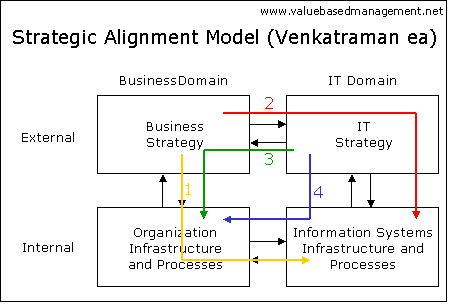
Aligning Business and IT Strategy

 |
Aligning Business and IT Strategy |
 |
|
Articles | Books | Dictionary | Faq | Home | Leaders | Organizations | Search
|
Strategic AlignmentVenkatraman |
Summary of the Strategic Alignment Model by Venkatraman. Abstract |
Venkatraman, Henderson, Oldach (1993) |
The Strategic Alignment model of Venkatraman, Henderson and Oldach is a framework to Aligning Business and IT Strategy.
Venkatraman ea argue in 1993 that the difficulty to realize value from IT investments is firstly due to the lack of alignment between the business and IT strategy of the organizations that are making investments, and secondly due to the lack of a dynamic administrative process to ensure continuous alignment between the business and IT domains.

They describe Four Dominant
Alignment Perspectives towards the analytic alignment of
Business and IT:
Strategy Execution: this perspective views the business strategy as the driver of both organization design choices and the logic of IS infrastructure (the classic, hierarchical view of strategic management). Top Management is strategy formulator, IS Management is strategy implementer. [Arrow 1]
Technology Potential: this perspective also views the business strategy as the driver, however involves the articulation of an IT strategy to support the chosen business strategy and the corresponding specification of the required IS infrastructure and processes. The top management should provide the technology vision to articulate the logic and choices pertaining to IT strategy that would best support the chosen business strategy, while the role of the IS manager should be that of the technology architect - who efficiently and effectively designs and implements the required IS infrastructure that is consistent with the external component of IT strategy (scope, competences and governance). [Arrow 2]
Competitive Potential: this alignment perspective is concerned with the exploitation of emerging IT capabilities to impact new products and services (i.e., business scope), influence the key attributes of strategy (distinctive competences), as well as develop new forms of relationships (i.e. business governance). Unlike the two previous perspectives that considered business strategy as given (or a constraint for organizational transformation), this perspective allows the modification of business strategy via emerging IT capabilities. The specific role of the top management to make this perspective succeed is that of the business visionary, who articulates how the emerging IT competences and functionality as well as changing governance patterns in the IT marketplace would impact the business strategy. The role of the IS manager, in contrast, is one of the catalyst, who identifies and interprets the trends in the IT environment to assist the business managers to understand the potential opportunities and threats from an IT perspective. [Arrow 3]
Service Level: This alignment perspective focuses on how to build world class IT/IS organization within an organization. In this perspective, the role of business strategy is indirect. This perspective is often viewed as necessary (but not sufficient) to ensure the effective use of IT resources and be responsive to the growing and fast-changing demands of the end-user population. The specific role of the top management to make this perspective succeed is that of the prioritizer, who articulates how best to allocate the scarce resources both within the organization as well as in the IT marketplace (in terms of joint ventures, licensing, minority equity investments, etc.). The role of the IS manager, in contrast, is one of business leadership, with the specific tasks of making the internai business succeed within the operating guidelines from the top management. [Arrow 4]
| 👀 | TIP: To learn more, have a look at the IT Strategic Alignment center: Summary, forum, tips and tools. |
Compare with Strategic Alignment: Twelve Principles of the Network Economy | 7-S framework | Organizational Configurations | Impact/Value framework
About us | Advertise | Privacy | Support us | Terms of Service
©2025 Value Based Management.net - All names tm by their owners